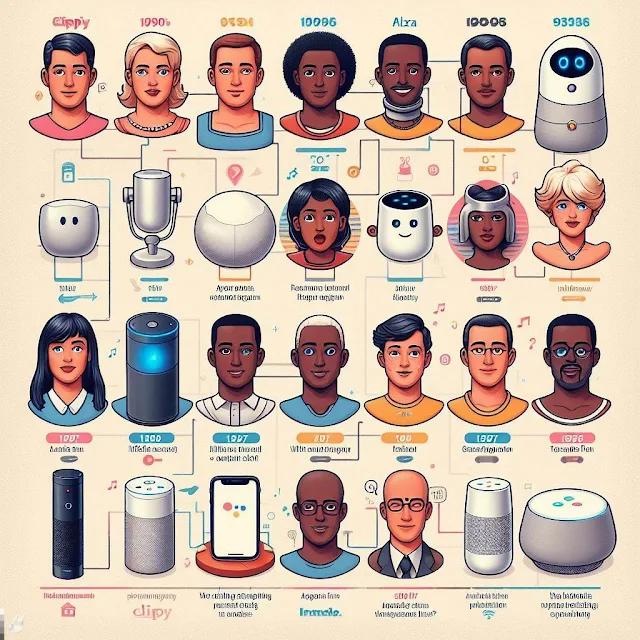The Evolution and Impact of Virtual Assistants: A Comprehensive Exploration
Introduction:
In the dynamic landscape of modern technology, Virtual Assistants (VAs) have emerged as versatile and indispensable tools, revolutionizing the way we interact with digital environments. From Siri and Google Assistant to Alexa and Cortana, these AI-driven marvels have transcended their initial roles, becoming integral components of our daily lives. In this comprehensive exploration, we delve into the evolution and impact of virtual assistants, tracing their journey from rudimentary command-followers to sophisticated, context-aware companions that navigate our tasks and enhance our productivity.
The
Genesis of Virtual Assistants:
Virtual Assistants had humble beginnings, primarily focused on executing basic commands and providing information based on preset queries. The earliest versions were limited in their capabilities, relying on programmed responses and lacking the adaptive learning capacities that define contemporary VAs.
1. **Early Voice Recognition Systems:**
The foundation of modern virtual assistants can be traced back to early voice recognition systems. These systems, although rudimentary, laid the groundwork for the integration of speech as a primary mode of interaction.
2. **Rule-Based Commands:**
Initially, VAs operated on rule-based command structures, responding to specific programmed instructions. These early models showcased the potential for hands-free, voice-activated interactions.
3. **Evolution of Natural Language Processing (NLP):**
A pivotal moment in the evolution of virtual assistants was the integration of Natural Language Processing (NLP). This breakthrough allowed VAs to understand and interpret user queries in a more human-like manner, expanding their utility and user-friendliness.
The
Rise of Intelligent Virtual Assistants:
The progression from rule-based commands to intelligent virtual assistants marked a paradigm shift, transforming these tools into context-aware, adaptive entities capable of learning from user interactions.
1. **Machine Learning and AI Integration:**
The incorporation of machine learning and artificial intelligence algorithms enabled VAs to evolve beyond predefined commands. They started learning from user behaviors, adapting responses based on context, and providing personalized assistance.
2. **Context-Aware Responses:**
Intelligent VAs became adept at understanding context, allowing for more natural and conversational interactions. Whether setting reminders, answering questions, or managing tasks, these assistants started to comprehend the nuances of human communication .
3. **Multifunctional Capabilities:**
Modern virtual assistants are multifunctional, seamlessly integrating into various aspects of our lives. From managing schedules and sending messages to controlling smart home devices, their versatility has made them invaluable assets.
Key Features of Contemporary Virtual Assistants:
1. **Voice Recognition and Activation:**
Contemporary VAs excel in voice recognition, accurately understanding and interpreting spoken commands. Activation phrases like "Hey Siri" or "OK Google" have become ingrained in our daily routines.
2. **Natural Language Understanding:**
Advanced NLP enables VAs to understand natural language queries, discerning intent and context for more nuanced interactions.
3. **Task Automation:**
VAs can execute a wide array of tasks, from setting reminders and sending messages to providing weather updates and initiating calls, streamlining our daily activities.
4. **Integration with Smart Devices:**
Seamless integration with smart devices allows VAs to control smart homes, adjusting thermostats, lighting, and security systems through voice commands.
5. **Continuous Learning and Improvement:**
Machine learning algorithms enable VAs to continuously learn from user interactions, refining their responses over time for a more personalized user experience.
Impact
on Daily Life:
The integration of virtual assistants into our daily lives has had a profound impact, streamlining tasks, and enhancing overall efficiency.
1. **Time Management:**
VAs assist in time management by setting reminders, scheduling appointments, and sending timely alerts, helping users stay organized.
2. **Information Retrieval:**
Users can quickly access information by posing natural language queries, ranging from general knowledge to specific details about personal preferences.
3. **Smart Home Control:**
The ability to control smart home devices through VAs adds a layer of convenience, allowing users to manage their living spaces effortlessly.
4. **Communication Facilitation:**
VAs facilitate communication by sending messages, making calls, and even composing emails, reducing the need for manual input.
5. **Accessibility:**
Virtual assistants enhance accessibility for individuals with disabilities, offering hands-free interaction and support for tasks that may be challenging otherwise.
Challenges
and Future Developments:
While virtual assistants have significantly evolved, challenges such as privacy concerns, potential biases, and the need for improved natural language understanding persist. The future promises continued advancements, including enhanced contextual awareness, better personalization, and increased integration with emerging technologies like augmented reality.
1. **Privacy and Security:**
The collection of user data for personalization raises privacy concerns. Striking a balance between customization and user privacy remains a challenge.
2. **Addressing Biases:**
Developers need to address biases in virtual assistants to ensure fair and unbiased responses, avoiding perpetuation of societal stereotypes.
3. **Improved Natural Language Understanding:**
Future developments aim to enhance natural language understanding, making interactions even more intuitive and context-aware.
4. **Integration with Emerging Technologies:**
Virtual assistants are likely to integrate with emerging technologies like augmented reality, providing users with immersive and hands-free experiences.
Conclusion:
The evolution and impact of virtual assistants underscore their transformative role in reshaping how we interact with technology. From their humble beginnings as rule-based command followers to the sophisticated, context-aware companions of today, virtual assistants have become integral to our daily lives. As they continue to evolve, addressing challenges and embracing future developments, virtual assistants are poised to play an increasingly significant role in shaping the way we navigate the digital landscape. Their journey is a testament to the dynamic synergy between artificial intelligence and our quest for more intuitive, efficient, and personalized digital experiences.








.jpg)






0 Comments